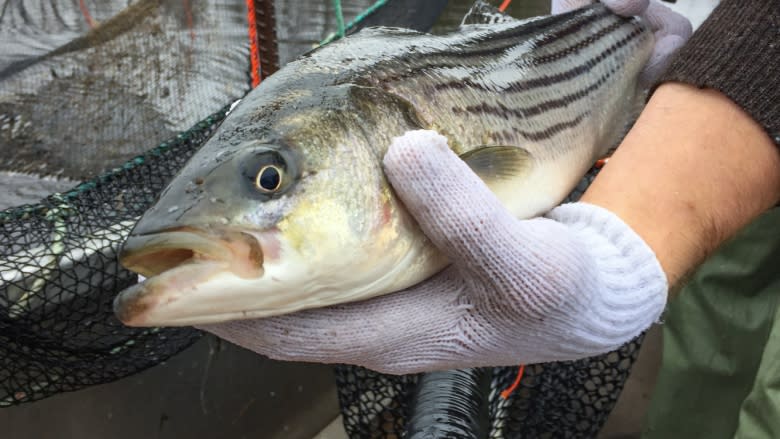Nova Scotia striped bass comeback prompts more study
Every day this week, federal Fisheries biologist Rod Bradford and a team from DFO are up at dawn checking a fish trap they've placed in the Shubenacadie River at Enfield near the Halifax Stanfield International Airport.
And every day, the net contains hundreds of striped bass, some measuring upwards of a metre long.
"There is a pile of fish in there," Bradford tells his colleagues as they paddle out on a flat-bottom aluminum boat.
The spring run of striped bass from Grand Lake, where they overwinter, to tidal water in the Bay of Fundy is a spectacle Bradford has watched closely since 1999.
"It's doing much better than when we began monitoring. In those days, we had few adult fish, no indications of an adult spawning population. With changes of regulation, with good fortune and good recruitment, we've seen rebuilding."
Acoustic monitoring
Now, in addition to counting, measuring and noting fish previously tagged or injuries from angling, the Fisheries Department is expanding monitoring efforts on what is the only healthy population of striped bass in the Bay of Fundy.
This year they are implanting acoustic trackers in some larger fish to monitor the impact of recreational fishing and to establish a baseline in case of future tidal power development in the bay.
"If we start to see changes in [the] biological character of the population, then you would start to ask questions, whether it's tidal power or whatever you have — an indication that there is something we should be looking at more closely," says Bradford.
Calculating the recreational haul
The trackers have an eight-year battery life. The signal will be picked up from listening devices called hydrophones installed in Grand Lake, the Shubenacadie River and Bay of Fundy.
DFO wants to estimate how many striped bass are being removed by a large and growing recreational fishery. Some 8,000 anglers identify themselves as striped-bass fishermen.
"I don't think it would be an exaggeration to state there are thousands being removed. That in itself isn't a serious issue; it's how you relate that to what's out there, that is the unknown," says Bradford.
"They seem to support it, but I think everyone would feel more comfortable as the fishery unfolds if we understood what the exploitation rate actually is."
Endangered population
The Committee on the Status of Endangered Wildlife in Canada considers the Bay of Fundy population endangered.
The bay has three distinct spawning populations: the Saint John River in New Brunswick and Nova Scotia's Shubenacadie and Annapolis rivers.
They have disappeared from the Annapolis River and are in serious trouble in the Saint John.
A 2014 status report prepared by DFO outlined pitfalls in the remaining stronghold.
"The primary threats facing the extant spawning population in the Shubenacadie River system are direct mortality through directed recreational angling and food, social and ceremonial fisheries and, to a lesser extent, illegal fishing [poaching] and bycatch in commercial fisheries," DFO reported.




